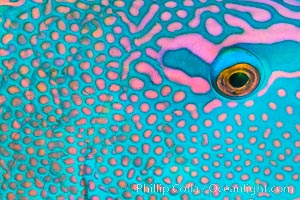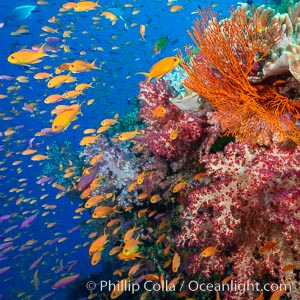
Brilliantlly colorful coral reef, with swarms of anthias fishes and soft corals, Fiji.
Species: Anthias, Dendronephthya soft coral, Dendronephthya, Pseudanthias
Location: Bligh Waters, Fiji
Image ID: 34723
Species: Anthias, Dendronephthya soft coral, Dendronephthya, Pseudanthias
Location: Bligh Waters, Fiji
Image ID: 34723

Sarcophyton leather coral on coral reef, Fiji.
Species: Sarcophyton soft coral, Sarcophyton
Location: Gau Island, Lomaiviti Archipelago, Fiji
Image ID: 34724
Species: Sarcophyton soft coral, Sarcophyton
Location: Gau Island, Lomaiviti Archipelago, Fiji
Image ID: 34724

Crinoid (feather star) extends its tentacles into ocean currents, on pristine south pacific coral reef, Fiji.
Species: Crinoid feather star, Crinoidea
Location: Namena Marine Reserve, Namena Island, Fiji
Image ID: 34725
Species: Crinoid feather star, Crinoidea
Location: Namena Marine Reserve, Namena Island, Fiji
Image ID: 34725

Beautiful South Pacific coral reef, with Plexauridae sea fans, schooling anthias fish and colorful dendronephthya soft corals, Fiji.
Species: Anthias, Dendronephthya soft coral, Gorgonian, Dendronephthya, Gorgonacea, Pseudanthias
Location: Namena Marine Reserve, Namena Island, Fiji
Image ID: 34726
Species: Anthias, Dendronephthya soft coral, Gorgonian, Dendronephthya, Gorgonacea, Pseudanthias
Location: Namena Marine Reserve, Namena Island, Fiji
Image ID: 34726

Brilliantlly colorful coral reef, with swarms of anthias fishes and soft corals, Fiji.
Species: Anthias, Dendronephthya soft coral, Dendronephthya, Pseudanthias
Location: Namena Marine Reserve, Namena Island, Fiji
Image ID: 34727
Species: Anthias, Dendronephthya soft coral, Dendronephthya, Pseudanthias
Location: Namena Marine Reserve, Namena Island, Fiji
Image ID: 34727

Closeup view of colorful dendronephthya soft corals, reaching out into strong ocean currents to capture passing planktonic food, Fiji.
Species: Dendronephthya soft coral, Dendronephthya
Location: Namena Marine Reserve, Namena Island, Fiji
Image ID: 34728
Species: Dendronephthya soft coral, Dendronephthya
Location: Namena Marine Reserve, Namena Island, Fiji
Image ID: 34728

Dendronephthya soft coral detail including polyps and calcium carbonate spicules, Fiji.
Species: Dendronephthya soft coral, Dendronephthya
Location: Namena Marine Reserve, Namena Island, Fiji
Image ID: 34729
Species: Dendronephthya soft coral, Dendronephthya
Location: Namena Marine Reserve, Namena Island, Fiji
Image ID: 34729
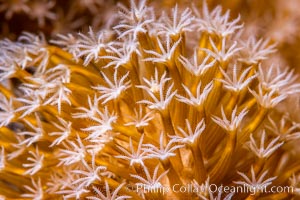
Sarcophyton leather coral polyp detail, close up view, Fiji.
Species: Sarcophyton soft coral, Sarcophyton
Location: Namena Marine Reserve, Namena Island, Fiji
Image ID: 34730
Species: Sarcophyton soft coral, Sarcophyton
Location: Namena Marine Reserve, Namena Island, Fiji
Image ID: 34730

Dendronephthya soft coral detail including polyps and calcium carbonate spicules, Fiji.
Species: Dendronephthya soft coral, Dendronephthya
Location: Namena Marine Reserve, Namena Island, Fiji
Image ID: 34731
Species: Dendronephthya soft coral, Dendronephthya
Location: Namena Marine Reserve, Namena Island, Fiji
Image ID: 34731

Blue ribbon eel, Rhinomuraena quaesita, leafnose moray eel, Fiji.
Species: Blue ribbon eel, Rhinomuraena quaesita
Location: Namena Marine Reserve, Namena Island, Fiji
Image ID: 34732
Species: Blue ribbon eel, Rhinomuraena quaesita
Location: Namena Marine Reserve, Namena Island, Fiji
Image ID: 34732

Golden Damselfish, Fiji.
Species: Golden damselfish, Amblyglyphidodon aureus
Location: Namena Marine Reserve, Namena Island, Fiji
Image ID: 34734
Species: Golden damselfish, Amblyglyphidodon aureus
Location: Namena Marine Reserve, Namena Island, Fiji
Image ID: 34734

Bignose Unicornfish, Naso vlamingii, being cleaned by a small wrasse, Fiji.
Species: Bignose unicornfish, Naso vlamingii
Location: Namena Marine Reserve, Namena Island, Fiji
Image ID: 34735
Species: Bignose unicornfish, Naso vlamingii
Location: Namena Marine Reserve, Namena Island, Fiji
Image ID: 34735
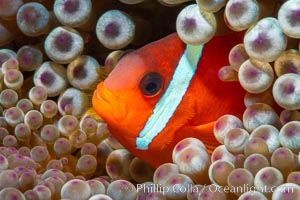
Fiji Barberi Clownfish, Amphiprion barberi, hiding among anemone tentacles, Fiji.
Species: Fiji barberi clownfish, Amphiprion barberi
Location: Namena Marine Reserve, Namena Island, Fiji
Image ID: 34736
Species: Fiji barberi clownfish, Amphiprion barberi
Location: Namena Marine Reserve, Namena Island, Fiji
Image ID: 34736
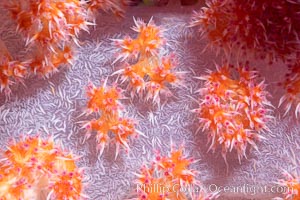
Dendronephthya soft coral detail including polyps and calcium carbonate spicules, Fiji.
Species: Dendronephthya soft coral, Dendronephthya
Location: Namena Marine Reserve, Namena Island, Fiji
Image ID: 34738
Species: Dendronephthya soft coral, Dendronephthya
Location: Namena Marine Reserve, Namena Island, Fiji
Image ID: 34738

Colorful and exotic coral reef in Fiji, with soft corals, hard corals, anthias fishes, anemones, and sea fan gorgonians.
Species: Anthias, Dendronephthya soft coral, Dendronephthya, Pseudanthias
Location: Fiji
Image ID: 34739
Species: Anthias, Dendronephthya soft coral, Dendronephthya, Pseudanthias
Location: Fiji
Image ID: 34739

Anthias fish school around green fan coral, Fiji.
Species: Anthias, Pseudanthias
Location: Fiji
Image ID: 34740
Species: Anthias, Pseudanthias
Location: Fiji
Image ID: 34740
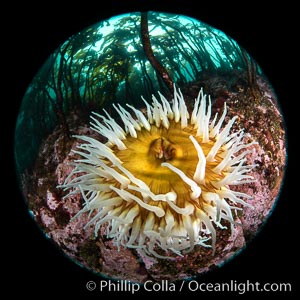
The Fish Eating Anemone Urticina piscivora, a large colorful anemone found on the rocky underwater reefs of Vancouver Island, British Columbia.
Species: Fish-eating anemone, Urticina piscivora
Location: British Columbia, Canada
Image ID: 35249
Species: Fish-eating anemone, Urticina piscivora
Location: British Columbia, Canada
Image ID: 35249

Giant Plumose Anemones cover underwater reef, Browning Pass, northern Vancouver Island, Canada.
Species: Giant plumose anemone, Metridium farcimen
Location: British Columbia, Canada
Image ID: 35251
Species: Giant plumose anemone, Metridium farcimen
Location: British Columbia, Canada
Image ID: 35251

Pink Soft Coral, Gersemia Rubiformis, Browning Pass, Vancouver Island.
Species: Pink soft coral, Gersemia rubiformis
Location: British Columbia, Canada
Image ID: 35254
Species: Pink soft coral, Gersemia rubiformis
Location: British Columbia, Canada
Image ID: 35254
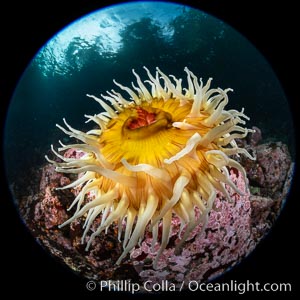
The Fish Eating Anemone Urticina piscivora, a large colorful anemone found on the rocky underwater reefs of Vancouver Island, British Columbia.
Species: Fish-eating anemone, Urticina piscivora
Location: British Columbia, Canada
Image ID: 35255
Species: Fish-eating anemone, Urticina piscivora
Location: British Columbia, Canada
Image ID: 35255
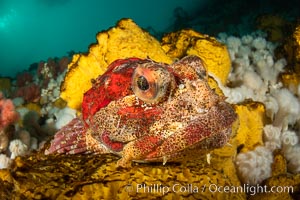
Red Irish Lord sculpinfish, Browning Pass, British Columbia.
Species: Red irish lord, Hemilepidotus hemilepidotus
Location: British Columbia, Canada
Image ID: 35256
Species: Red irish lord, Hemilepidotus hemilepidotus
Location: British Columbia, Canada
Image ID: 35256

Giant Plumose Anemones cover underwater reef, Browning Pass, northern Vancouver Island, Canada.
Species: Giant plumose anemone, Metridium farcimen
Location: British Columbia, Canada
Image ID: 35284
Species: Giant plumose anemone, Metridium farcimen
Location: British Columbia, Canada
Image ID: 35284
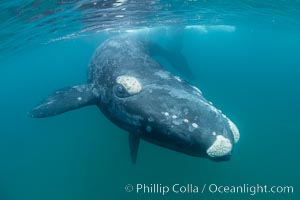
Southern right whale underwater, Eubalaena australis, Argentina.
Species: Southern right whale, Eubalaena australis
Location: Puerto Piramides, Chubut, Argentina
Image ID: 35906
Species: Southern right whale, Eubalaena australis
Location: Puerto Piramides, Chubut, Argentina
Image ID: 35906
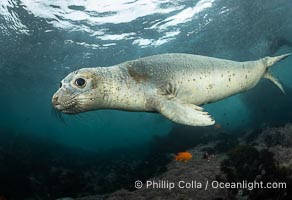
Juvenile Northern Elephant Seal Underwater, Coronado Islands, Mexico.
Species: Elephant seal, Mirounga angustirostris
Location: Coronado Islands (Islas Coronado), Baja California, Mexico
Image ID: 36465
Species: Elephant seal, Mirounga angustirostris
Location: Coronado Islands (Islas Coronado), Baja California, Mexico
Image ID: 36465

California Sea Lions Underwater, Coronado Islands, Baja California, Mexico.
Species: California sea lion, Zalophus californianus
Location: Coronado Islands (Islas Coronado), Baja California, Mexico
Image ID: 36467
Species: California sea lion, Zalophus californianus
Location: Coronado Islands (Islas Coronado), Baja California, Mexico
Image ID: 36467

South American sea lions underwater, Otaria flavescens, Patagonia, Argentina.
Species: South American Sea Lion, Otaria flavescens
Location: Puerto Piramides, Chubut, Argentina
Image ID: 38269
Species: South American Sea Lion, Otaria flavescens
Location: Puerto Piramides, Chubut, Argentina
Image ID: 38269

Mother and calf southern right whales underwater. The calf swims close to its mother but, if the mother is accepting, the calf will be allowed to come close to the photographer and check him out.
Species: Southern Right Whale, Eubalaena australis
Location: Puerto Piramides, Chubut, Argentina
Image ID: 38313
Species: Southern Right Whale, Eubalaena australis
Location: Puerto Piramides, Chubut, Argentina
Image ID: 38313

Southern right whale eyeballing the camera up close, Eubalaena australis. Whale lice can be seen clearly in the folds and crevices around the whales eye and lip groove.
Species: Southern Right Whale, Eubalaena australis
Location: Puerto Piramides, Chubut, Argentina
Image ID: 38401
Species: Southern Right Whale, Eubalaena australis
Location: Puerto Piramides, Chubut, Argentina
Image ID: 38401

